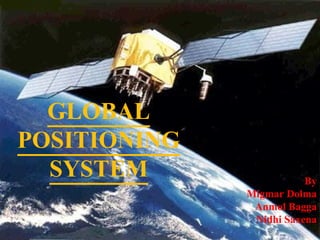Recommended
More Related Content
What's hot
What's hot (20)
Global navigation satellite system based positioning combined

Global navigation satellite system based positioning combined
Viewers also liked
Viewers also liked (20)
CE6404 ANNA UNIVERSITY Unit iii total station surveying

CE6404 ANNA UNIVERSITY Unit iii total station surveying
Similar to Gps
Similar to Gps (20)
More from Anmol Bagga
More from Anmol Bagga (11)
Smart : Comprehensive and unified framework for test automation of web and mo...

Smart : Comprehensive and unified framework for test automation of web and mo...
Recently uploaded
Recently uploaded (20)
How to Troubleshoot Apps for the Modern Connected Worker

How to Troubleshoot Apps for the Modern Connected Worker
Apidays New York 2024 - The value of a flexible API Management solution for O...

Apidays New York 2024 - The value of a flexible API Management solution for O...
AWS Community Day CPH - Three problems of Terraform

AWS Community Day CPH - Three problems of Terraform
Repurposing LNG terminals for Hydrogen Ammonia: Feasibility and Cost Saving

Repurposing LNG terminals for Hydrogen Ammonia: Feasibility and Cost Saving
Polkadot JAM Slides - Token2049 - By Dr. Gavin Wood

Polkadot JAM Slides - Token2049 - By Dr. Gavin Wood
Apidays New York 2024 - Scaling API-first by Ian Reasor and Radu Cotescu, Adobe

Apidays New York 2024 - Scaling API-first by Ian Reasor and Radu Cotescu, Adobe
EMPOWERMENT TECHNOLOGY GRADE 11 QUARTER 2 REVIEWER

EMPOWERMENT TECHNOLOGY GRADE 11 QUARTER 2 REVIEWER
Apidays New York 2024 - Accelerating FinTech Innovation by Vasa Krishnan, Fin...

Apidays New York 2024 - Accelerating FinTech Innovation by Vasa Krishnan, Fin...
ProductAnonymous-April2024-WinProductDiscovery-MelissaKlemke

ProductAnonymous-April2024-WinProductDiscovery-MelissaKlemke
Cloud Frontiers: A Deep Dive into Serverless Spatial Data and FME

Cloud Frontiers: A Deep Dive into Serverless Spatial Data and FME
2024: Domino Containers - The Next Step. News from the Domino Container commu...

2024: Domino Containers - The Next Step. News from the Domino Container commu...
Axa Assurance Maroc - Insurer Innovation Award 2024

Axa Assurance Maroc - Insurer Innovation Award 2024
"I see eyes in my soup": How Delivery Hero implemented the safety system for ...

"I see eyes in my soup": How Delivery Hero implemented the safety system for ...
Strategies for Unlocking Knowledge Management in Microsoft 365 in the Copilot...

Strategies for Unlocking Knowledge Management in Microsoft 365 in the Copilot...
Why Teams call analytics are critical to your entire business

Why Teams call analytics are critical to your entire business
Gps
- 1. GLOBAL POSITIONING SYSTEM By Migmar Dolma Anmol Bagga Nidhi Saxena
- 4. 3 Segments of GPS Control Segment Space Segment User Segment Monitor Stations Ground Antennas Master Station GPS
- 6. GPS Ground Control Stations Currently there are only five GPS monitoring station that feed the Master Control Station. GPS
- 17. How does it work? GPS
- 19. What do you think? GPS 19000KM
- 22. Sources Of Error Sometimes the signals bounces off even before they hit the receivers or follow multipath . GPS are Line of sight transmission which is the ability to transmit between two objects without any other objects getting in the way. GPS
- 28. In a Nutshell GPS

